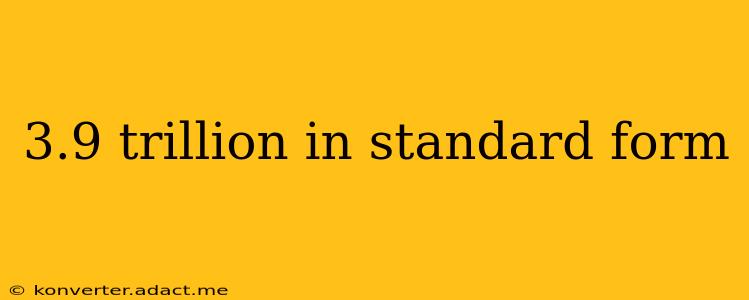Understanding large numbers like trillions is crucial in various fields, from finance and economics to science and technology. This guide will explain how to express 3.9 trillion in standard form, also known as scientific notation, and delve into related concepts.
Standard form, or scientific notation, is a way of writing very large or very small numbers concisely. It follows the format: A x 10B, where A is a number between 1 and 10 (but not including 10), and B is an integer representing the power of 10.
Expressing 3.9 Trillion in Standard Form
First, let's define a trillion: 1 trillion is equal to 1,000,000,000,000 (one followed by twelve zeros), or 1012.
Therefore, 3.9 trillion can be expressed as 3.9 x 1012. This is the standard form representation. The number 3.9 is our 'A' value, and 12 is our 'B' value. It neatly encapsulates the magnitude of the number.
Frequently Asked Questions about Standard Form and Large Numbers
Here, we address some common questions related to expressing large numbers in standard form:
What is the difference between standard form and scientific notation?
The terms "standard form" and "scientific notation" are often used interchangeably. Both refer to the same method of expressing numbers as a coefficient multiplied by a power of 10. The key difference is primarily in regional usage; scientific notation is more common in scientific and technical writing across the globe, while "standard form" is more frequently used in certain educational systems.
How do I convert a number from standard form to its expanded form?
To convert a number from standard form (like 3.9 x 1012) to its expanded form, simply multiply the coefficient (3.9) by 10 raised to the power of the exponent (12). This means moving the decimal point twelve places to the right. The result is 3,900,000,000,000.
How do I convert a large number into standard form?
Converting a large number to standard form involves these steps:
- Identify the coefficient: This is the number you obtain by placing a decimal point after the first digit.
- Count the number of places: Count how many places you need to move the decimal point to the left to get to the coefficient. This count becomes your exponent (B).
- Write it in standard form: Put the coefficient (A) followed by "x 10B" where B is the number of places you moved the decimal point.
For example, let’s convert 7,500,000,000 to standard form:
- Coefficient: 7.5
- Number of places to move the decimal point left: 9
- Standard form: 7.5 x 109
Are there any other ways to represent 3.9 trillion?
While 3.9 x 1012 is the most concise and universally accepted standard form, you could also represent it as 3,900,000,000,000 (expanded form). However, standard form is preferred for its clarity and ease of use when dealing with extremely large or small numbers.
By understanding and applying these methods, you can confidently work with large numbers like 3.9 trillion and express them effectively in standard form for various applications.
